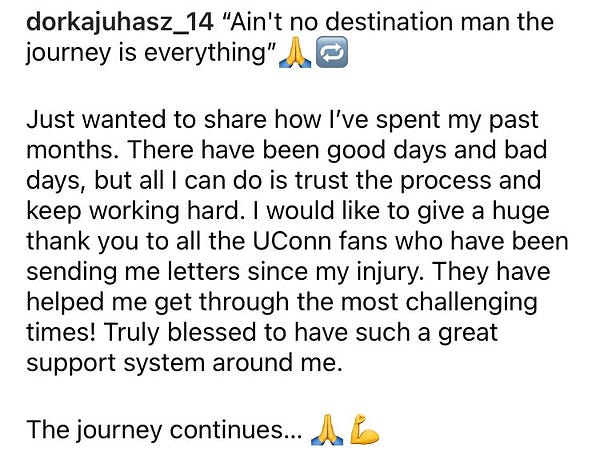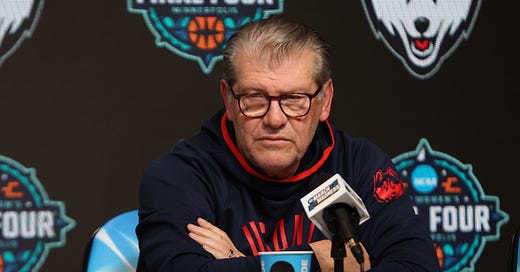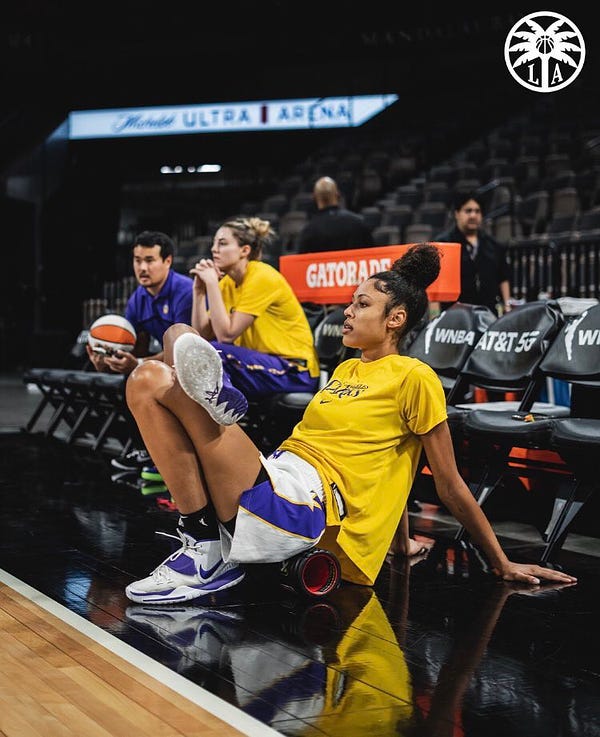"It's the dumbest thing ever": Geno rails against combined Final Four
UConn’s head coach is strongly against the idea of hosting the men’s and women’s Final Four site in the same city.
Welcome to the UConn WBB Weekly, a recap of everything that happened in the world of UConn women’s basketball over the past week from the team that runs The UConn Blog.
Sign up to get the Weekly in your inbox every Thursday or subscribe to get our premium newsletter which includes film breakdowns, analysis, recruiting coverage and more!
Headlines
From the UConn WBB Weekly Premium:
From The UConn Blog:
Last week’s Weekly:
“It’s the dumbest thing ever”
After 2021 highlighted the massive disparities between the men’s and women’s NCAA Tournaments, the NCAA commissioned an independent review of gender inequity in collegiate sports. The Kaplan Report laid out the deep divide between men’s and women’s athletics are treated and made recommendations for how those differences could be addressed.
Among its recommendations: Hold the men’s and women’s Final Four together on the same weekend in the same city. It’s not a novel idea — Big East commissioner Val Ackerman wrote a white paper on the topic in 2013 — but one that’s come to the forefront as a result of the debacle during the 2021 tournaments.
Don’t count Geno Auriemma among its supporters, though.
“The only thing that won’t work is having the women’s Final Four at the same place where they have the men’s. A lot of people are pushing for that. That’s the dumbest thing ever,” he said at the UConn Coaches Road Show last Tuesday. “Anybody who’s ever been to the men’s Final Four — which I have — and anybody who’s been to a women’s Final Four — which, I’ve been to a couple — it’s the dumbest thing ever.
“There’s a lot of models to choose from. But playing the same place as the guys (will) never happen. Shouldn’t happen. Travesty if it does happen. [It’s] disrespectful to us.”
Auriemma also isn’t alone in his conviction.
“Every coach that I’ve talked to that’s participated in the Final Four — and I’ve talked to quite a few after the report came out — not a one said we should have both Final Fours at the same place,” he said at the Final Four in Minneapolis this past April.
The thinking behind the proposal is that since the men’s tournament attracts more sponsors, media, and overall attention, the women’s tournament would benefit from being in the same location. However, the men’s tournament could overshadow the women’s tournament instead of elevating it.
There are other drawbacks. With men’s and women’s fans converging on the same, prices for flights and hotels could skyrocket past the already-surged prices. It would also limit how many cities could host since the men’s Final Four is only held in domed football stadiums — of which there are 12 around the country. Meanwhile, five of the last 10 women’s Final Fours — and two of the next four — were in cities that don’t have a domed football stadium.
But for now, everything will stay the same. In February, the NCAA voted to keep the men’s and women’s Final Fours separate, which means the setup should stay that way through 2032, when the television rights for the men’s tournament expire.
That doesn’t mean other changes to the women’s tournament aren’t on the horizon.
Beginning in 2023, there will be just two regional sites instead of four. There’s also been a recent push from some in the women’s game to host the first two rounds at neutral sites — like the men’s tournament — instead of on the home court of the top four seeds in every region.
The NCAA has tried that before. Starting in 2003, schools were allowed to bid to host the first two rounds but couldn’t do so more than two years in a row. In 2005, the format changed to mirror the men’s tournament with neutral sites for the early rounds, though that ended after just four years due to poor attendance. From 2009-2015, there were 16, pre-determined sites for the opening rounds and since 2016, the top four seeds have hosted.
In Auriemma’s opinion, simply copying the men’s tournament isn’t the best way to maximize the women’s tournament.
“Men’s basketball is the only sport that can get away with what they do because that’s how popular they are and that’s how much money they generate,” he said. “No one can play every game at the neutral sites in the NCAA Tournament...no one else can do that.”
Geno isn’t completely opposed to changing things up. ESPN’s Debbie Antonelli has the idea of creating a jamboree of sorts by moving all Sweet Sixteen and Elite Eight contests to Las Vegas. Auriemma likes the concept of a single site, though his inspiration comes from the College World Series, where Omaha and Oklahoma City host the final eight teams in baseball and softball, respectively.
“I think the baseball model is a great model, right? They all go out to Omaha and those people out there, they embrace it. It’s a week-long, two-week-long celebration. They’ve got all kinds of events out there and they own the whole state of Nebraska for those two weeks,” he said. “Softball’s doing it in Oklahoma City. So there’s something to be said for bringing everybody to one site.”
The two-site regionals should be a litmus test to see how a more centralized format works in the women’s game. If those are successful, it’s possible a single-site regional could follow either in 2027 — the next year with no set locations for regionals — or beyond.
Until then, Greenville, South Carolina, and Seattle will hold the regionals with the Final Four in Dallas for 2023 followed by Albany, New York, and Portland, Oregon for regionals and a Cleveland Final Four in 2024; Birmingham, Alabama, and Spokane, Washington leading to a Tampa Final Four in 2025; and Fort Worth, Texas, and Sacramento, California regions before a Phoenix Final Four in 2026.
Best of social media
Dorka Juhász provides an update on her recovery:



Dorka Juhász and Caroline Ducharme went to the Connecticut Sun game on Tuesday:
Lou and Liv in LA:








